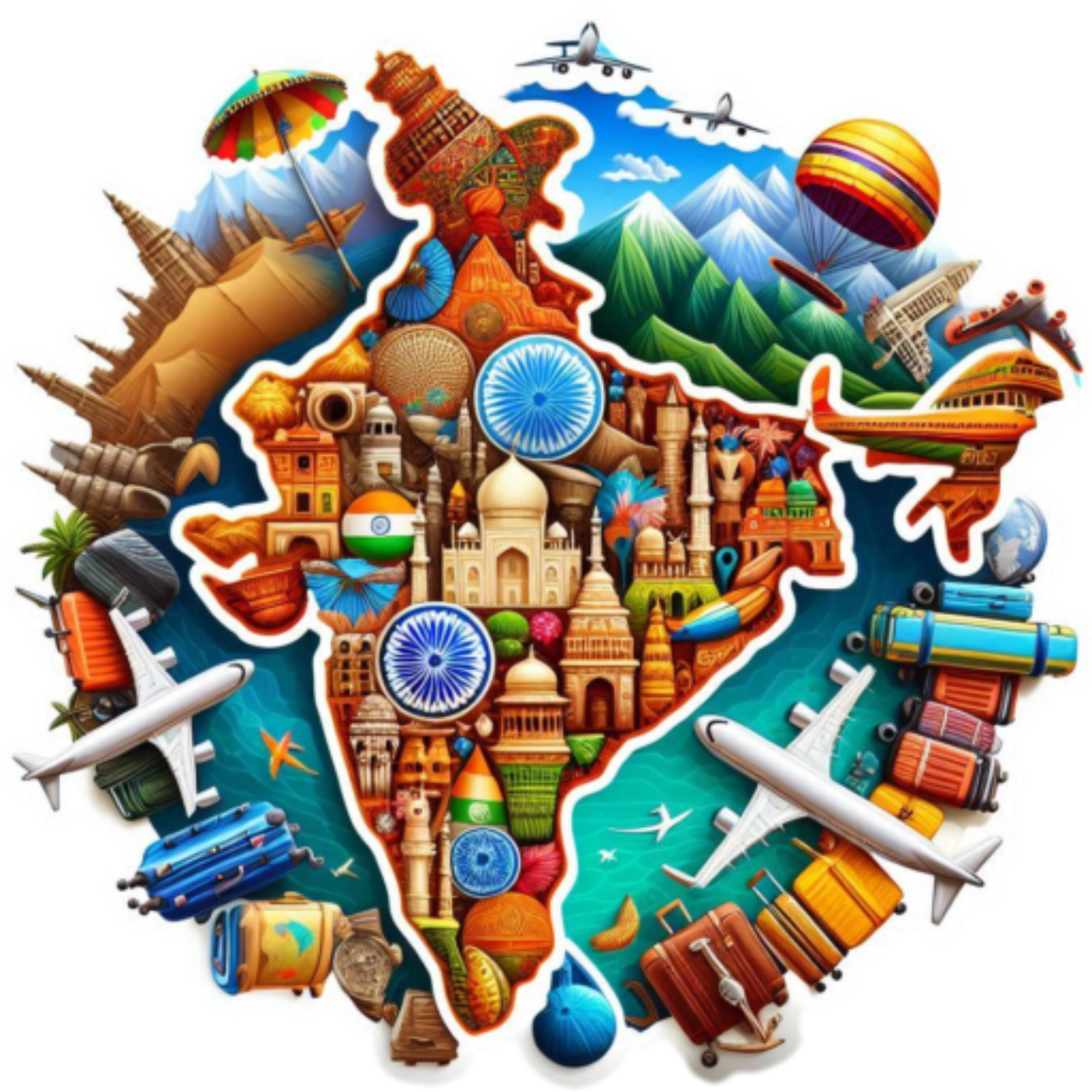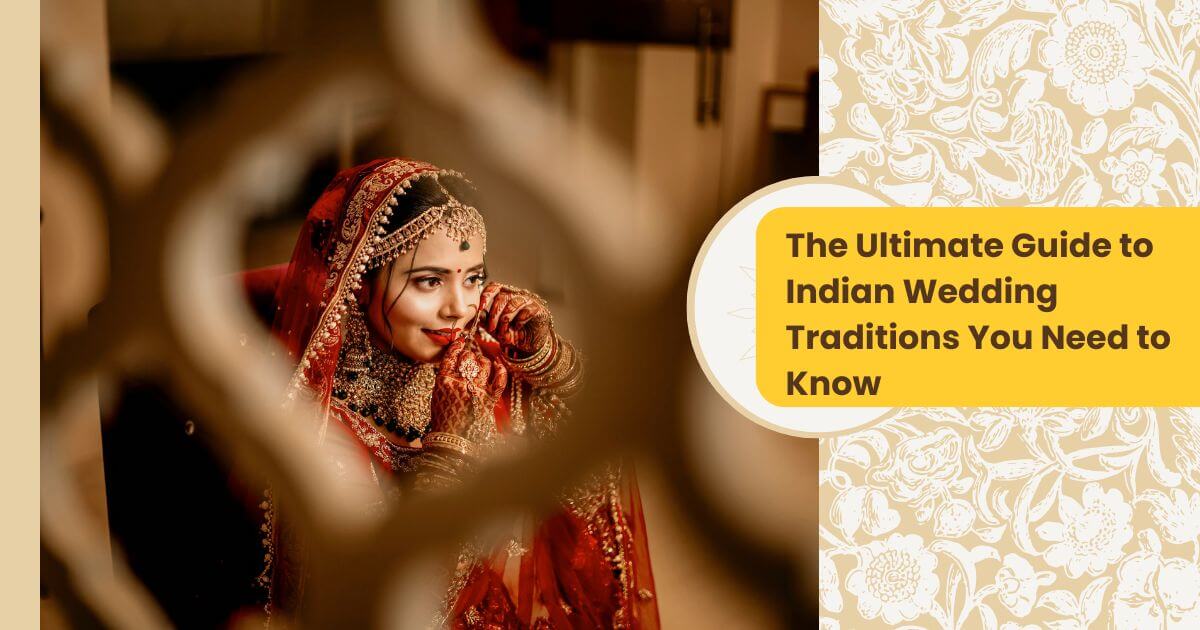Introduction to Indian Weddings
Indian weddings are a big topic and can’t be covered in one post. So we will break it down into a series of posts that will go deeper into different aspects of Indian wedding traditions.
Before we start, just a note that India has multiple religions and cultures, each with their philosophies, traditions and rituals. Our context will be on Hindu weddings as most of the common knowledge about Indian weddings comes from the diverse practices within Hindu culture. We don’t claim to be experts on Christian or Islamic weddings.
Also within Hinduism itself, wedding customs differ by region: South Indian weddings are different from North Indian weddings which are different from Western and Eastern Indian weddings. But there are common threads that run across all. As society evolves with urbanization, popular culture, social media and intercultural marriages, some wedding formats have gained popularity. We will focus on these commonalities even if they may not meet a traditionalist’s expectations. If you need specific details on a particular custom, please let us know and we will be happy to help.
So let’s start.
What is the cultural significance of weddings in India?
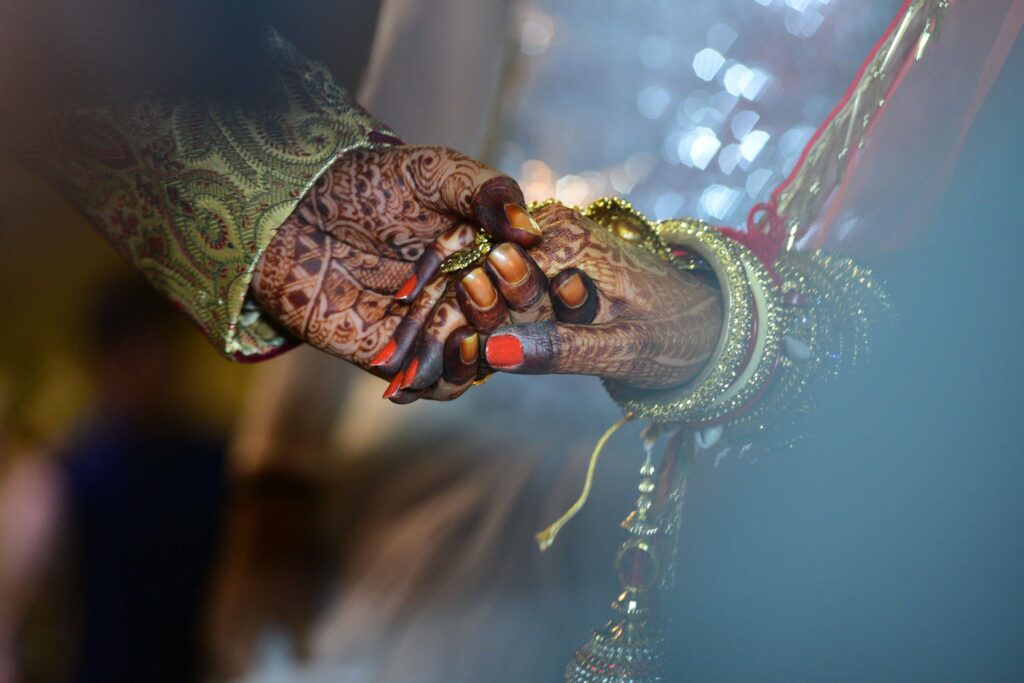
An Indian wedding is not just about a man and a woman; it’s about two families coming together, the couple being the connecting link between them. The prayers recited during these ceremonies are from the Vedas and the rituals are from the Puranas. The main inspiration for any Indian Wedding comes from Sita’s Swayamwar, where she chose Lord Ram as her husband. This has been beautifully described in the two books, Sri Ramcharit Manas & Valmiki’s Ramayana, which are considered the authority on Lord Ram’s life story.
The wedding date is normally decided as per the Hindu calendar or Panchang.
Indian weddings are big events where extended family members who are spread all over the world get to come together and celebrate. So planning happens over several months with guest lists, accommodation, and other activities.
Earlier weddings were informal gatherings where the bride’s family used to handle most of the logistics. But with the rise of banquet halls and professional wedding planners, the wedding industry has become a big business in India and now weddings are professionally managed events.
What is the process of an Indian Wedding?
Indian weddings are a series of events that culminate in a significant focal point, which we will discuss later. These celebrations often span several days or even months. Throughout the ceremony, two parallel threads are woven together: the ritualistic thread and the cultural one. The ritualistic aspect is overseen by an appointed Brahmin, also known as Panditji, who conducts the poojas, chants, and havan derived from the Vedas, alongside exemplary stories from the Puranas. Meanwhile, family members manage the cultural thread, which encompasses festivities, food, dance, and other joyous activities.
Mangani or Sagai
The first significant step in this sequence is known as the Mangani, Sagai, or Engagement Ceremony, though it may be referred to by various names across different subcultures. This event formally announces the couple’s betrothal during which the bride and groom exchange rings. In some communities, the Mangani occurs a few months before the main wedding, while in others, it takes place just a day before. As families gather to celebrate this initial union, the appointed priest performs a solemn pooja for the couple.
Mehandi
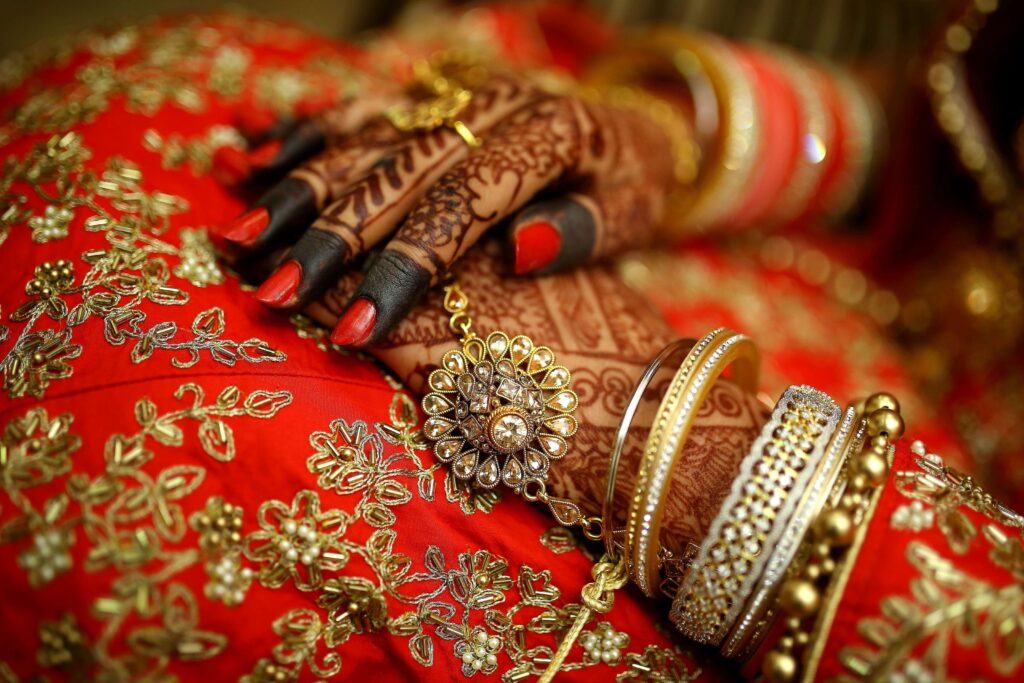
Mehendi (Henna), is a traditional ceremony primarily celebrated by the bride’s family. During this event, all the women gather around the bride as a professional henna artist designs intricate art to her hands and feet. In certain communities, the bride’s family extends invitations to women from the groom’s side, fostering a sense of unity and celebration.
As the henna is being applied, the atmosphere is lively, with women enjoying themselves and dancing to traditional tunes. In some cases, multiple henna artists may be invited to accommodate all the participating women. While the event is predominantly centred around the bride’s family, it is not uncommon for members of the groom’s family to join in the festivities, enriching the overall experience.
Tilak
The Tilak ceremony, characterized by the application of a vermilion mark on the forehead, has long been an integral aspect of Hindu culture. Even today, men often don a Tilak before embarking on significant journeys or endeavours.
In the context of Indian weddings, this ceremony is an elevated expression of the same age-old tradition. Typically, it is the bride’s father or a designated representative who applies the Tilak to the groom, symbolizing the commencement of a new familial relationship. This event may take place at either the groom’s or the bride’s home, depending on the customs of the respective community.
Haldi
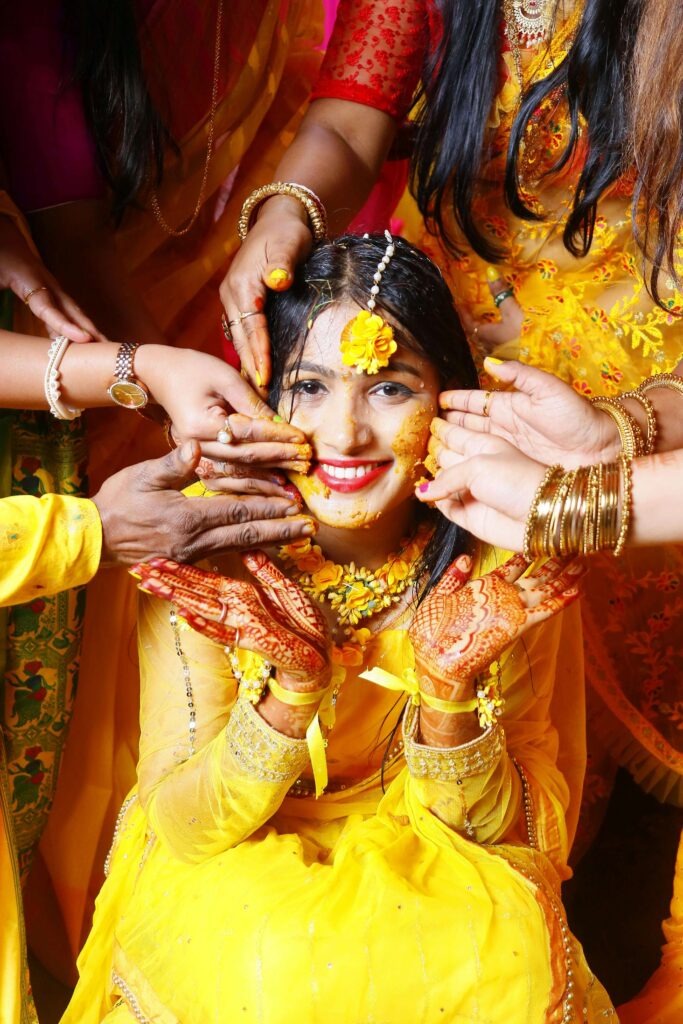
Haldi (turmeric), holds significant cultural importance in Indian weddings. It is considered auspicious and is believed to ward off negative energies. Beyond its spiritual symbolism, haldi possesses therapeutic properties that cleanse the skin and impart a radiant glow—qualities that are particularly desirable for the newlyweds.
During this vibrant ceremony, the women of the bride’s family gather in the early morning to apply haldi to the bride. As they sing traditional songs, they also participate in a ceremonial bathing ritual. This practice is mirrored at the groom’s home, creating a joyful atmosphere that celebrates the union of the couple.
Sangeet
The Sangeet is a vibrant and joyous celebration held one or two days before the main wedding ceremony. By this time, both families have completed all necessary rituals and logistical preparations. During this festive evening, family members from both sides come together to dance to traditional folk songs and engage in light-hearted teasing. This relaxed atmosphere helps to break down formal barriers and fosters stronger bonds among family members. Of course, the evening is complemented by a continuous flow of delicious food, making it a truly memorable occasion.
Baaraat

On the wedding day, the groom’s family arrives at the main venue in a festive procession known as the Baraat. Friends and family gather at a designated location near the venue and proceed with great fanfare, accompanied by a live band, dazzling lights, fireworks, and lively dancing. The Baraat is a spectacular event, often featuring the groom elegantly mounted on a horse, surrounded by revellers as they make their way to the wedding place.
Main Wedding Event
The layout of the Indian wedding venue typically begins with a grand, beautifully decorated entrance leading to a designated area for guest seating and socializing. Let’s call it the Event Section.
At the centre, there is a stage where the newlywed meets with the guests and takes their blessing. In more elaborate weddings, this stage may also host musical and dance performances by professional artists.
Mandap (or Mandapam) is the most important area where the primary wedding rituals are performed, and the marriage ceremony is consummated.
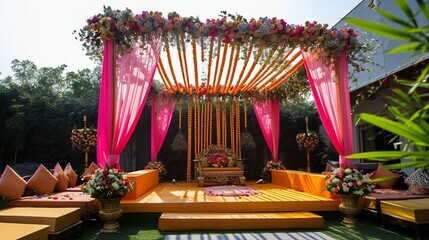
Typically, the buffet is situated at the opposite end of the venue to maintain the sanctity of the wedding rites. Many guests may not attend the main ceremony in the Mandap; instead, they greet the couple on stage, enjoy the food, and then depart. Generally, it is the close family and friends who partake in the full wedding rituals.
Returning to the sequence of events, the Baraat is warmly received by the bride’s family at the venue. Depending on the sub-culture, it may be the bride’s father or her brother who formally welcomes the groom. In both cases, a Pooja is conducted to honour the groom’s arrival.
Then the groom is escorted to the Event Section where he awaits the bride. Accompanied by her sisters, female relatives and friends, the bride joins him onstage with a lot of pomp and show. The first significant ritual, known as Varmala, takes place here, during which the bride and groom exchange garlands. Guests then take turns joining the couple on stage to offer gifts and well-wishes for their new life together.
As previously mentioned, the concept of auspicious days, or Panchang, plays a significant role in wedding planning. This is the moment to focus on identifying the Shubh Muhoorat, or the auspicious hour, for performing the wedding Pooja, which is the most critical ceremony ritual.
Following the Varmala, the couple remains on stage until the Vivaah Muhoorat begins, at which point they proceed to the Mandap. The Mandap serves as the focal point of the wedding, where all significant rituals take place. In many communities, the couple observes a fast until the completion of the wedding, while in others, they continue to enjoy food throughout the festivities.
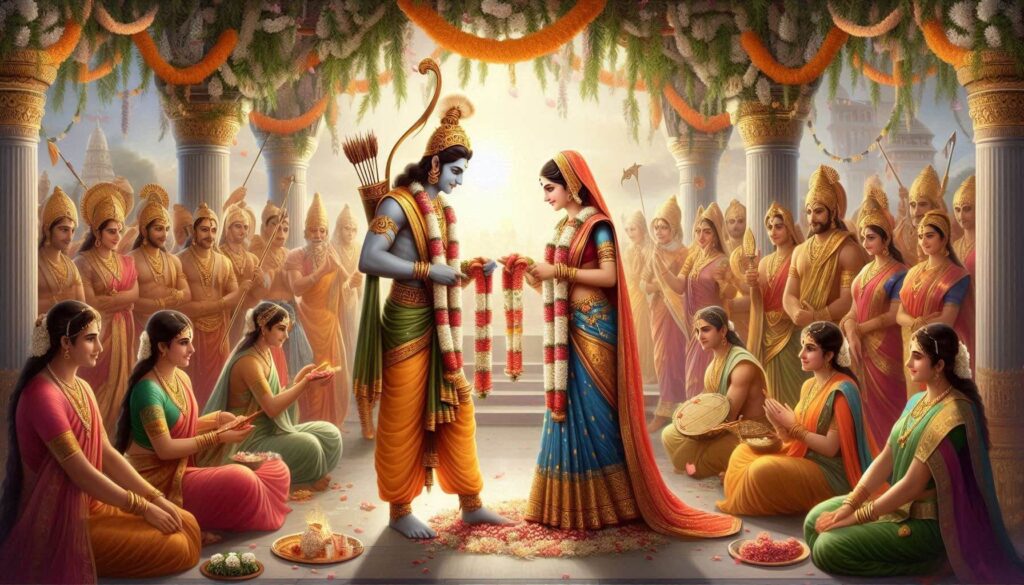
At the designated Muhoorat, the couple enters the Mandap, where they sit together and perform the rituals under the guidance of the Panditji, who oversees the ceremony.
The main wedding consists of three pivotal steps:
- Havan Rituals: This important ceremony occurs in front of a sacred fire, which has been revered since Vedic times. Fire symbolizes the Sun, providing warmth and light essential for life on Earth.
- Kanyadaan: During this ritual, the bride’s father formally entrusts the care of his daughter to the groom, who vows to cherish and protect her. The Panditji recites traditional chants, invoking the fire as a witness to these sacred oaths.
- Sindoor Ceremony: The groom applies Sindoor (vermillion), to the bride’s forehead, signifying her new status as a married woman.
- Pheras: The Panditji ties a sacred cloth around the bride and groom, symbolizing their eternal bond. They then take seven circumambulations around the fire, each representing a vow they make to each other.
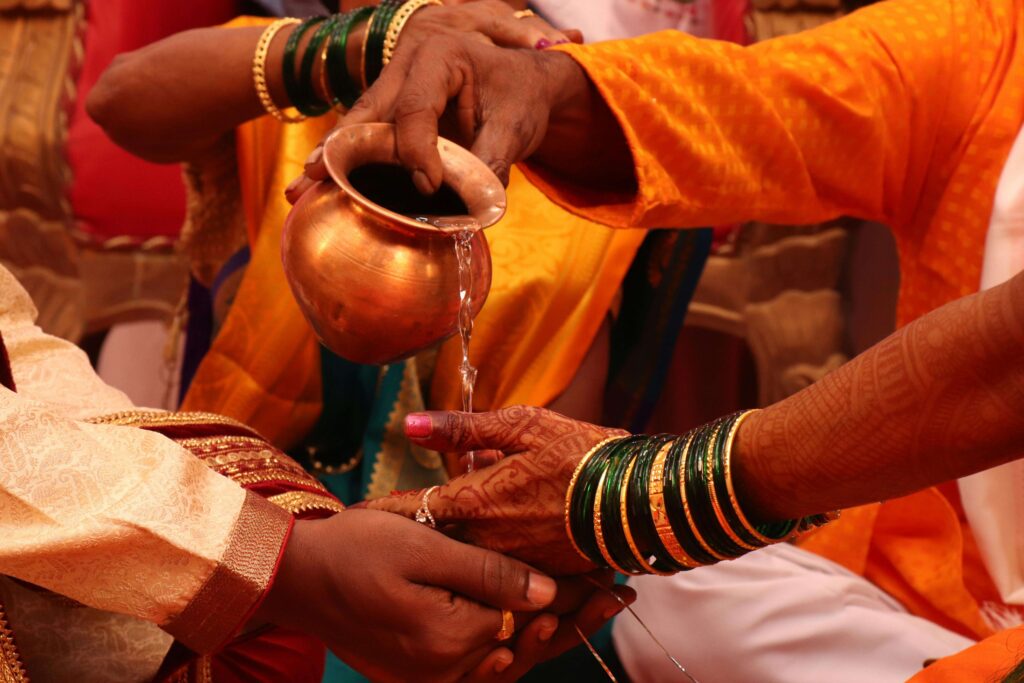
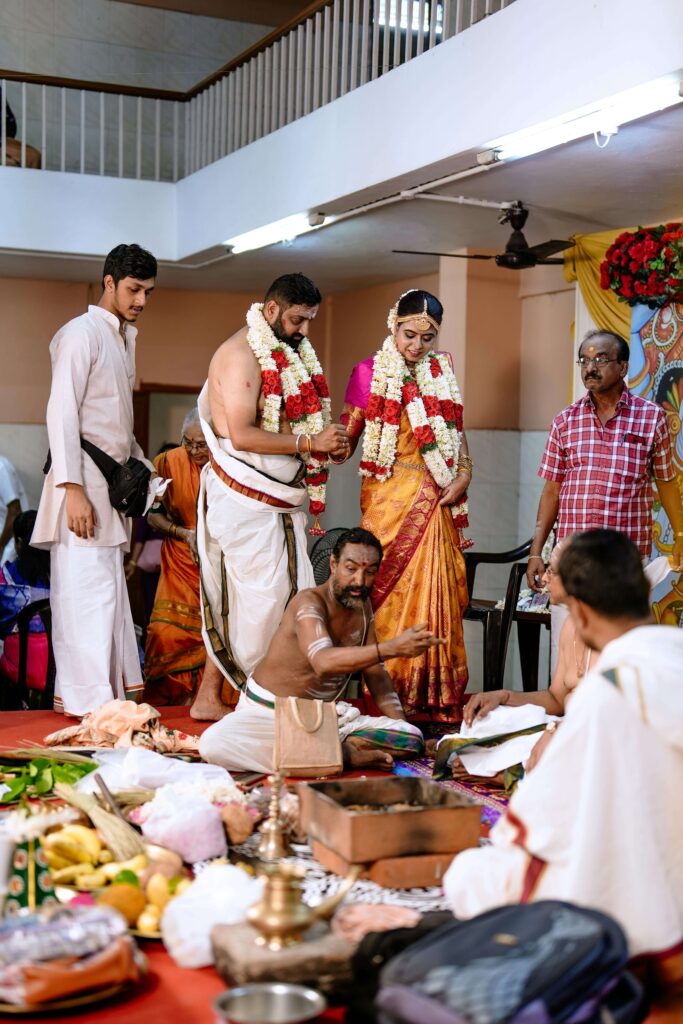
The entire process conducted in the Mandap is central to any Indian wedding.
Post Wedding Rituals
Similar to the main event, there is a designated Muhoorat for the newlywed’s departure. At the appropriate time, the family bids farewell, marking the final ritual performed by the Panditji. This poignant moment, known as Vidai, is often filled with emotion for the bride’s family.
Following the wedding, there are customary post-wedding functions, including a welcoming ceremony for the bride and a reception hosted by the groom’s family in her honour. This reception brings together both families and their friends once more. Usually, this celebration occurs three or four days later, allowing everyone time to recuperate and giving the bride—now acclimating to her new household—time to settle in.
Indian Wedding Dress
In India, wedding attire for men and women represents a distinct fashion genre characterized by elaborate designs, royal aesthetics, and intricate embroidery. Each wedding event calls for a special outfit tailored to its significance. For instance, during the Haldi (turmeric) ceremony, the bride and groom typically don vibrant shades of spring yellow. The bride usually wears a yellow cotton saree, which is practical given that she will be washed afterwards as part of the ritual. The groom, in turn, often wears a yellow cotton kurta pyjama for this morning’s celebration at his home.
For other ceremonies, brides typically choose between lehengas or richly adorned sarees with traditional drapes. Grooms wear long kurtas or sherwanis, which are equally decorative. Many grooms also wear headgear such as a Pag, Pagadi, or Safa, and may carry a stole or scarf draped over their shoulders.
Close family members coordinate their outfits with the couple and each other, albeit in a more subdued manner. Guests, depending on their relationship with the couple, select attire that varies in extravagance.
Indian Wedding Food

India is celebrated for its diverse culinary landscape, and weddings serve as a showcase of this gastronomic richness. The menu is typically shaped by the families’ regional, caste, and cultural backgrounds. Most weddings feature a buffet organized into several sections, including appetizers, the main course, desserts, and beverages. In addition to the buffet, stewards often serve a variety of snacks directly at the tables during the event.
Key items that have become staples at Indian weddings include:
- Snacks: Finger foods such as paneer-stuffed pakoras, dry vegetable kebabs, dry vegetable Manchurian (an Indian twist on Chinese cuisine), miniature samosas, and paneer and mushroom tikkas, all accompanied by an array of chutneys and sauces.
- Starters & Appetizers: A selection of chaat varieties, bhel puri, and salads.
- Main Course: Dishes like rice, pulav, poori, a variety of rotis, kachoris, dal makhani, paneer butter masala, besan ki kadi, kofta curry, methi aloo, and kabuli channa.
- Desserts: An assortment of kheer, and malpua served with rabri, gulab jamun, and ice cream.
- Drinks: Refreshing options like lemonade, aam panna, coffee preparations, kokum sherbet, and commercial soft drinks.
It’s worth noting that non-vegetarian options are generally absent unless the wedding belongs to a specific community, as the inclusion of non-veg dishes is a relatively recent trend, influenced by popular tastes and preferences. Traditionally, the wedding of Lord Ram and Sita serves as a cultural reference, as Hindu deities are not associated with non-vegetarian fare.
While many families engage professional caterers to provide standardized dishes, there is a rising trend toward serving Satvik food, which aligns with specific Hindu dietary principles. Notably, the variety and flavour of dishes remain abundant, even within the framework of Satvik guidelines.
How the Indian Weddings are changing: The Good & The Bad
Blending Cultures: Traditionally, weddings in India involved brides and grooms from the same community, ensuring consistency in rituals and practices. Many of these rituals were reciprocal, possible only when both individuals shared the same cultural background. In contemporary times, intercultural and interracial marriages have introduced complexities that challenge the spiritual essence of these unions.
Historically, even in ancient times, international marriages existed, with specific protocols established for the priests through Yagna and other ritualistic practices. However, significant changes occurred during the mid-modern historical period, leading to the loss of much of India’s literary heritage, including crucial portions of the Vedas. This has resulted in a fragmented understanding of rituals today. Only a few knowledgeable Brahmins remain well-versed in these traditions, while many families rely on commercially available Panditji to perform ceremonies, and prioritize entertainment over authenticity.
The Shift from Arranged Marriages to Love Marriages: This transition is a noteworthy phenomenon in India that is interesting trivia. Historically, marriages were orchestrated by relatives, as previously mentioned. However, with the increasing participation of women in the workforce, greater independence, and the overall liberalization of society, there has been a growing acceptance of the idea that couples should know each other well before marriage.
While this practice is common in the West, it is a relatively recent development in India. Traditional marriages, arranged by family members, contrast with what is now called “love marriages,” where individuals independently decide to unite. The term “love marriage” has its roots in Bollywood culture, and we will discuss this topic in further detail in a future post.
Shortening of the Guest List: As a child, I fondly recall attending extravagant weddings that boasted over 500 guests, featuring lavish feasts and ceremonies that spanned weeks. Reflecting on those times, it’s evident how much the world has transformed.
Several factors contribute to the shrinking guest list in contemporary weddings: migration patterns, smaller family sizes, the rise of destination weddings, and the pressures of modern work schedules. Additionally, family members increasingly seek independence and emotional support outside of their immediate circles, which can lead to a sense of distance among relatives.
In the past, most marriages were arranged, and weddings often served as social events where families sought to identify suitable partners for their children. Today, however, the dynamics of relationships and celebrations have shifted significantly.
Ritualistic Practices Giving Way to Entertainment: Historically, the tradition of Indian weddings is deeply rooted in Hinduism, which delineates various life stages, including marriage. These wedding customs are intertwined with the Hindu pursuit of Moksha, or spiritual liberation, guiding individuals through significant phases of life.
It is important to note that Hinduism does not prohibit enjoyment and entertainment. Ancient texts, particularly Valmiki’s Ramayana, celebrate life’s joyous aspects in rich detail. Originally, weddings were viewed as spiritual milestones, signifying the transition from Brahmacharya Ashram (the student phase) to Grihastha Ashram (the household phase) with a sacred approach.
Today, however, this spiritual essence is increasingly overshadowed by material pleasure underlined by elaborate costumes, Bollywood music, and significant Western cultural influences. This shift has led to a focus on entertainment, which alters the fundamental nature of these traditional ceremonies. Fortunately, many young couples are eager to reconnect with their roots, seeking to blend traditional values with modern celebrations.
Quick Tip: To gauge whether a wedding prioritizes entertainment over the true spirit of Sanatan (another name for Hinduism), observe the Varmala ceremony. If it involves playful teasing and friends lifting the bride or groom to hinder the garlanding process, it leans towards fun. Conversely, if the rituals are executed with grace and without competitive antics, the event takes inspiration from the tradition.
Tips, if you are a guest at Indan Wedding
I take it that you are not Indian and are unfamiliar with the do. Here are some top tips that will help you take care of your etiquette and you can enjoy the festivities as insiders.
How to Dress for an Indian Wedding
When attending an Indian wedding, women should avoid outfits that reveal their legs, such as skirts or shorts. While traditional Indian attire like sarees or lehenga cholis may expose the midriff or back, the key is to dress modestly and with cultural sensitivity. Embrace this difference and wear it gracefully.
It’s best to steer clear of black and white, as these colours carry a connotation different from celebrations in Indian culture. Instead, opt for vibrant hues that allow you to express your style. If you have the opportunity, purchasing traditional outfits like a saree or lehenga can make you feel regal and fully engaged in the celebration.
For men, a kurta pajama is a great way to blend in with the family, though suits are also acceptable. Consider wearing a Jodhpuri suit or a Bundi for a stylish integration with the Indian heritage, but avoid black suits.
Gift-Giving Etiquette in an Indian Wedding
Monetary gifts are widely accepted, primarily for their convenience. Present cash in a decorative envelope, and you may notice a $1 or Re1 coin attached. In Indian tradition, gifts of money are often given in denominations of one (e.g., 11, 21, 51, 101) as symbols of blessings. You may also consider giving a nice bouquet. Friends and family often gift household items, cutlery, or jewellery to help the bride set up her new home. However, it’s essential to know the family well, as large gifts can be cumbersome to transport.
Participating in the Indian Wedding
Engage in the festivities by dancing and encouraging others. There will be ample opportunities to do so! Be open to trying different cuisines, and if you’re comfortable, sit at the mandap to witness the rituals performed by the priest. You may find inspiration from these traditions that could spark a desire to visit India.
